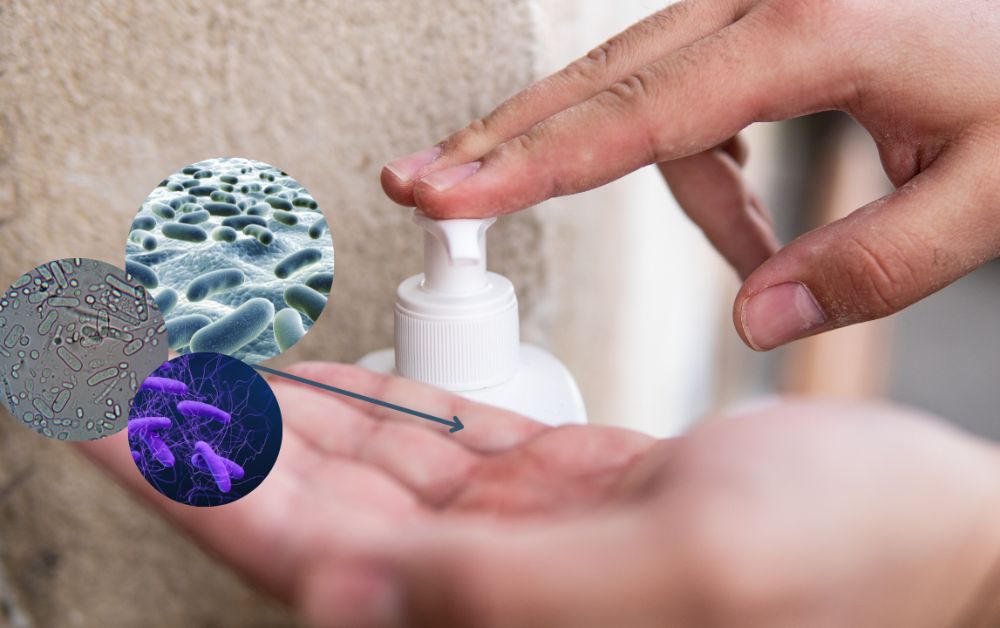
August 17, 2022
4 min
Euraneg
Here’s why you should change your dispenser’s pump regularly!
When it comes to protecting yourself from the transmission of pathogens, hand hygiene plays a prominent role.
But do you know what the disinfectant dispenser at your doctor’s office, at the supermarket, at your favorite designer’s or at your favorite restaurant is filled with?
Is it a BIOZIDE or a DRUG?
And what is the difference anyway?
If the hand sanitizer (HDM) contains one or more prescription substances, it is considered a drug and must be approved as such before it can be marketed.
Furthermore, an HDM is considered a drug if it is intended primarily for medical purposes.
For the evaluation of efficacy, both for medicinal products and for biocides, the European standards 20-26 and in Germany also the corresponding methods of the VAH 27, as well as the guideline of the German Association for the Control of Viral Diseases (DVV) e.V. and the Robert Koch Institute (RKI) 28 are used as a basis. The quality of a drug is subject to pharmaceutical standards, whereas the quality of a biocide is solely subject to the standards of the manufacturer.
In addition to water, refatting agents and fragrances, the most important active ingredients are alcohols – primarily propanol-2, ethanol, propanol-1 and isopropanol. They have been tried and tested for decades and show good compatibility and efficacy.
Ethanol has a microbiostatic effect (inhibiting the multiplication of microbes such as bacteria, viruses, fungi, etc.) above a concentration of about 10% and a microbiocidal effect (killing) above 30%. Although enveloped viruses are affected by all alcohols in a concentration-dependent manner, ethanol is more effective than propanols, particularly against non-enveloped viruses. To inactivate non-enveloped viruses, a high ethanol concentration (> 80 %) is usually required. The optimum concentration for killing bacteria is between 70- 80 %.
N-propanol (1-propanol, n-propyl alcohol, C3H7OH) is the most potent antibacterial alcohol compared to ethanol and isopropanol at the same concentration. The microbiocidal effect already starts at a concentration of 13 %, the optimal effective range is between 50-60 %. Of all the alcohols, n-propanol has the best efficacy against (murine) noroviruses – solutions with a 50 % concentration already achieve the required reduction of 4 lg.
Ultimately, when selecting a suitable HDM, it is important to combine the efficiency of the various alcohols with optimum skin protection for the individual application.
The choice of disinfectants is wide. Many different products are offered on the market for different areas and applications. Various disinfectant lists have been established to provide the user with guidance in the selection process.
A) The disinfectant list of the VAH (Verbund für angewandte Hygiene e.V.) is the standard reference for HDM in routine use in medical and non-medical facilities. It is a unique, manufacturer-independent compilation of certified products that not only meet European requirements, but also the latest requirements of the VAH and its cooperating professional societies. Recommended in relevant KRINKO and AWMF guidelines.
B) Since February 1, 2019, the IHO (Industrieverband Hygiene und Oberflächenschutz für industrielle und institutionelle Anwendung e. V.) publishes free of charge the most comprehensive overview of effective disinfectants (>1,100) in Europe. Thanks to a user-friendly sorting function, the IHO Disinfectants List (www.desinfektionsmittelliste.de) provides professionals in the professional cleaning and hygiene field with a quick overview of disinfectants and their effectiveness for the application areas of healthcare, the food industry, and animal husbandry.
With this article, we wanted to show that regardless of the liquid used (oils, creams, soap or HDM), there is always a risk of contamination of the system in open systems (use of opened Euro bottles in a dosing dispenser). The best way to prevent this is therefore to regularly replace the dispenser pump with each bottle change.
To help you do this, Euraneg offers a recall service that reminds you by email every 3 months to replace the pump.
If you are interested in this service, please send us an e-mail to team@euraneg.com with the subject “Recall”.
Your Euraneg Team
Source:
https://www.doctors.today/a/was-alkohole-koennen- 1771801#:~:text=Die%20Wirkung%20dieser%20einwertigen%2C%20aliphatischen,eine%20Reihe%20von%20Mikroorganismen%20erzielen.
https://arnowa.de/Hygieneportal/Haendedesinfektion-Arzneimittel-oder-Biozide)
Quo vadis
Hübner N-O, Schwebke I, Kramer A: Wirkstoffe der alkoholischen Händedesinfektionsmittel – ein Beitrag zum Internationalen Tag der Händehygiene. Epidemiologisches Bulletin, 2016. 17: p. 143-146
Hübner N-O et al.: Aspekte der Hautverträglichkeit, des Hautschutzes und der Hautpflege. Epidemiologisches Bulletin, 2015. 18: p. 149-152
Hübner N-O, Eggers M, Schwebke I, Suchomel M: Händedesinfektion unter den Bedingungen der SARS-CoV-2-Pandemie Epid Bull 2020;19:13-20. DOI: 10.25646/686





